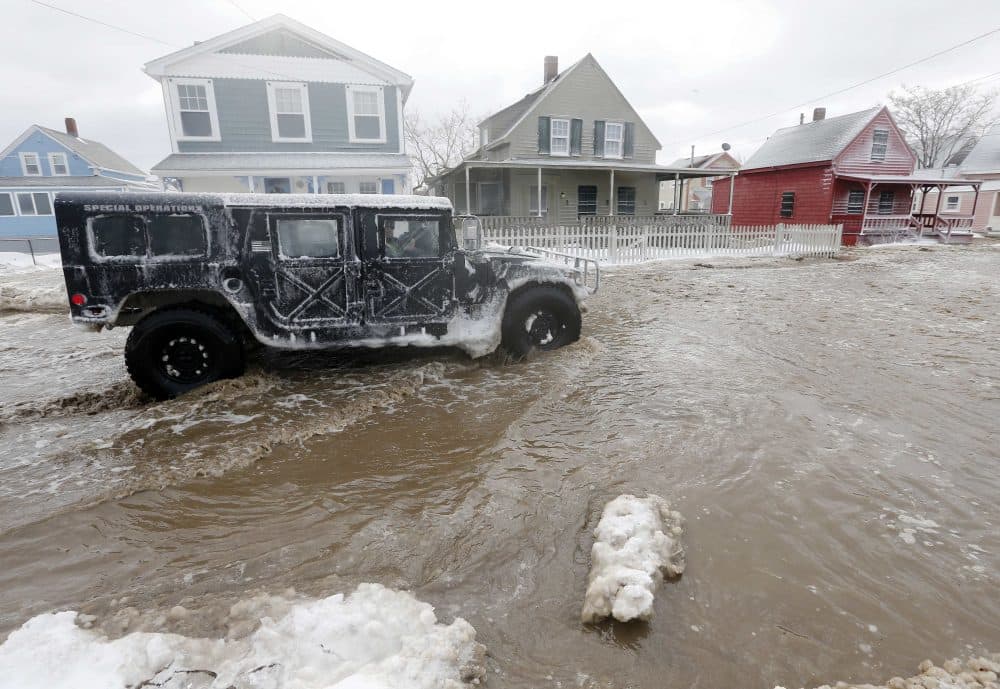Advertisement
Sea Level Rise Could Threaten 90,000 Homes In Mass., Study Finds

If nothing is done to curb greenhouse gas emissions from their current levels — and if the world as it's known to climate scientists doesn’t shift in some dramatic way — the coastal communities of Massachusetts could face a grim reality.
By the end of the century, a new study from the Union of Concerned Scientists finds that sea level rise could cause half the homes in Hull to face flooding every other week. That goes for a third of the homes in Cambridge, Provincetown and Salisbury — and at least 10 percent of the homes in 21 other coastal communities in the state.
In Boston alone, 32,640 homes could face the threat of chronic flooding, the study finds, pointing to a group of homes that now constitute more than $80 million of the city's tax revenue.
Over the next 30 years, the study finds 1,100 homes in Revere could face flooding every other week. In Nantucket, a billion dollars worth of homes could be at risk, and across the Massachusetts coast, nearly 14,000 people could be hit by chronic flooding.
The study — "Underwater: Rising Seas, Chronic Floods, and the Implications for US Coastal Real Estate" — was overseen by climate scientist Kristy Dahl of the Union of Concerned Scientists.
Dahl says the near-term threat to coastal properties has been flying under the radar. So her team took the latest climate data (the 2014 National Climate Assessment), and mixed it with the latest housing data (Zillow), to quantify and locate the threat of sea level rise.
“We knew that the data existed to understand this risk better, and so we wanted to analyze that data so that people are more able to see the threat clearly,” Dahl said.
The study suggests that if nothing changes, some 90,000 homes valued at $63 billion could face chronic flooding by the end of the century — and that’s just in Massachusetts.
Across the country, 2.5 million residential and commercial properties, valued at over $1 trillion, could face flooding, on average, every other week.
But understanding the threat of the coming decades is potentially even more important than the long term. Dahl says the more immediate the threat, the quicker people tend to act.
“When you start to look at this chronic flooding rather than this permanent inundation, you find that the decision point shifts decades earlier,” Dahl said, citing a previous study from the UCS that looked at permanent flooding. "So whereas something may not be underwater at every high tide until the end of the century, it could be experiencing this frequent flooding that makes life as we know it challenging decades earlier.”
The near term forecast is less daunting, but should still serve as a wakeup call. In 2030, the study points to 3,303 properties as facing chronic flooding, with a combined value of $2 billion.
Revere is the municipality with the greatest number of homes at risk (573), followed by Hull (491), Salisbury (457), Quincy (354) and Winthrop (200). Some 6,500 people live in these “at-risk” homes, according to the study.
The team also looked at whether the threat of sea level rise could disproportionately affect blacks and Hispanics and less affluent areas generally. Massachusetts was among eight states where at least 60 percent of the homes at risk over the next three decades are valued at less than the state’s median home value.
“There are some communities where homes that are right along the water are the most extravagant, the highest valued homes,” Dahl said. "But we also know that there are towns, like Revere, where they are kind of solidly working class places… [which have] some combination of a low-lying topography, relatively dense population and a concentration of homes that are valued below the state median.”
Dahl said racial disparities in homes threatened by sea level rise exist in some parts of the country — particularly Louisiana -- but that on the whole, wealth is a stronger determinant.
The new study looks strictly at the threat posed by sea level rise, without taking into consideration the more complicated factors of storms and rain-induced flooding. Dahl says that could be the subject of future research.
